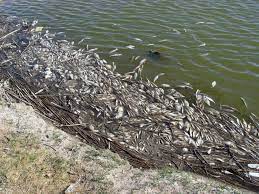Prymnesium parvum : Toxic Algal Bloom

A new report by the European Union (EU) investigating has confirmed that the destruction of fish in the River Oder in Poland was caused by the toxic algal bloom Prymnesium parvum made possible by anthropogenic factors.
- Prymnesium parvum is a microscopic, single-celled alga with four morphologically distinct forms.
- Three of the forms are scaled, bi-flagellated, and have a flexible, non-coiling, needle-like filament called a haptonema and the fourth form is a scaled, non-motile, siliceous cyst.
- It inhabits a variety of water bodies including rivers, lakes, estuaries, fjords, coastal oceans, and ponds, including eutrophic, alkaline, and brackish waters.
- It can reproduce rapidly and form a nearly monocultural bloom by releasing toxins into the water that immobilize or kill zooplankton and other phytoplankton to increase available food sources.
- It can survive in a range of water temperatures, from 5°C to 35°C, with blooms increasing between 10°C to 27°C.
- It is mixotrophic, supporting its growth with autotrophy (photosynthesis) or heterotrophy if nutrients are scarce.




